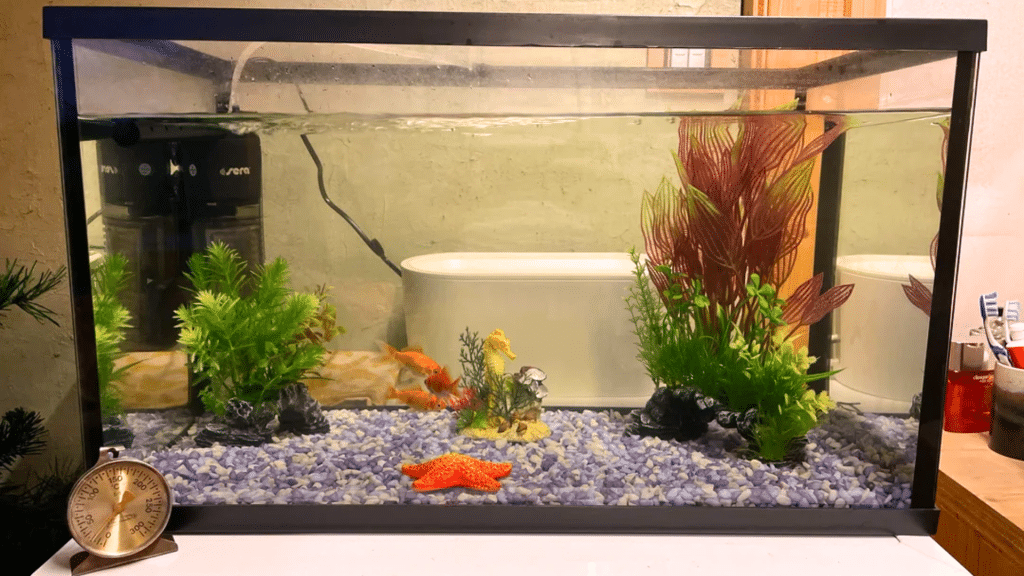Keeping your fish happy starts with one simple habit: cleaning their tank the right way.
I know it can feel tricky at first, especially if you’re worried about harming your fish or messing up the setup. But once you learn the right steps, it becomes quick, easy, and even relaxing.
A clean tank means clear water, fewer algae problems, and fish that stay active and healthy.
In this post, I’ll show you exactly how to clean your fish tank with some easy steps.
You’ll learn what supplies to grab, how to clean without stressing your fish, and how to keep the water crystal clear week after week.
By the end, you’ll know how to care for your aquarium with ease, no long cleaning sessions required.
Why Regular Fish Tank Cleaning Matters?
Regular fish tank cleaning keeps your aquarium healthy and balanced. When you clean it often, you stop algae from building up and avoid unpleasant smells.
Clean water helps keep the right chemical balance, which is vital for your fish to stay active and stress-free.
It also lowers the risk of diseases that can spread quickly in dirty tanks. A routine cleaning doesn’t just protect your fish; it also helps your filter, heater, and other equipment last longer.
When your tank runs smoothly, your fish stay healthy, and the water stays clear. Regular maintenance makes tank care easier and prevents bigger problems later.
A few minutes of cleaning each week can go a long way in keeping your fish happy and your aquarium running smoothly.
Tools and Supplies You’ll Need
Keeping the right tools on hand makes cleaning faster and safer for your fish. Below is a quick list of essentials and how each one helps keep your tank in top shape.
- Algae scrubber or sponge: Helps remove algae from the glass without scratching it, keeping the view clear.
- Gravel vacuum or siphon: Cleans dirt, food bits, and waste from the gravel while changing the water.
- Water conditioner: Removes chlorine and harmful chemicals from tap water, making it safe for fish.
- Bucket (for tank water only): Used for removing and refilling water; never mix it with cleaning chemicals.
- Clean cloth and net: The cloth wipes the tank’s exterior, and the net helps move fish gently if needed.
How to Clean a Fish Tank?
Keeping your aquarium clean is key to healthy fish and clear water. In this guide, I’ll show you some easy steps to clean your tank, care for the filter, and keep everything looking fresh.
Step 1: Prepare and Remove Removable Decor
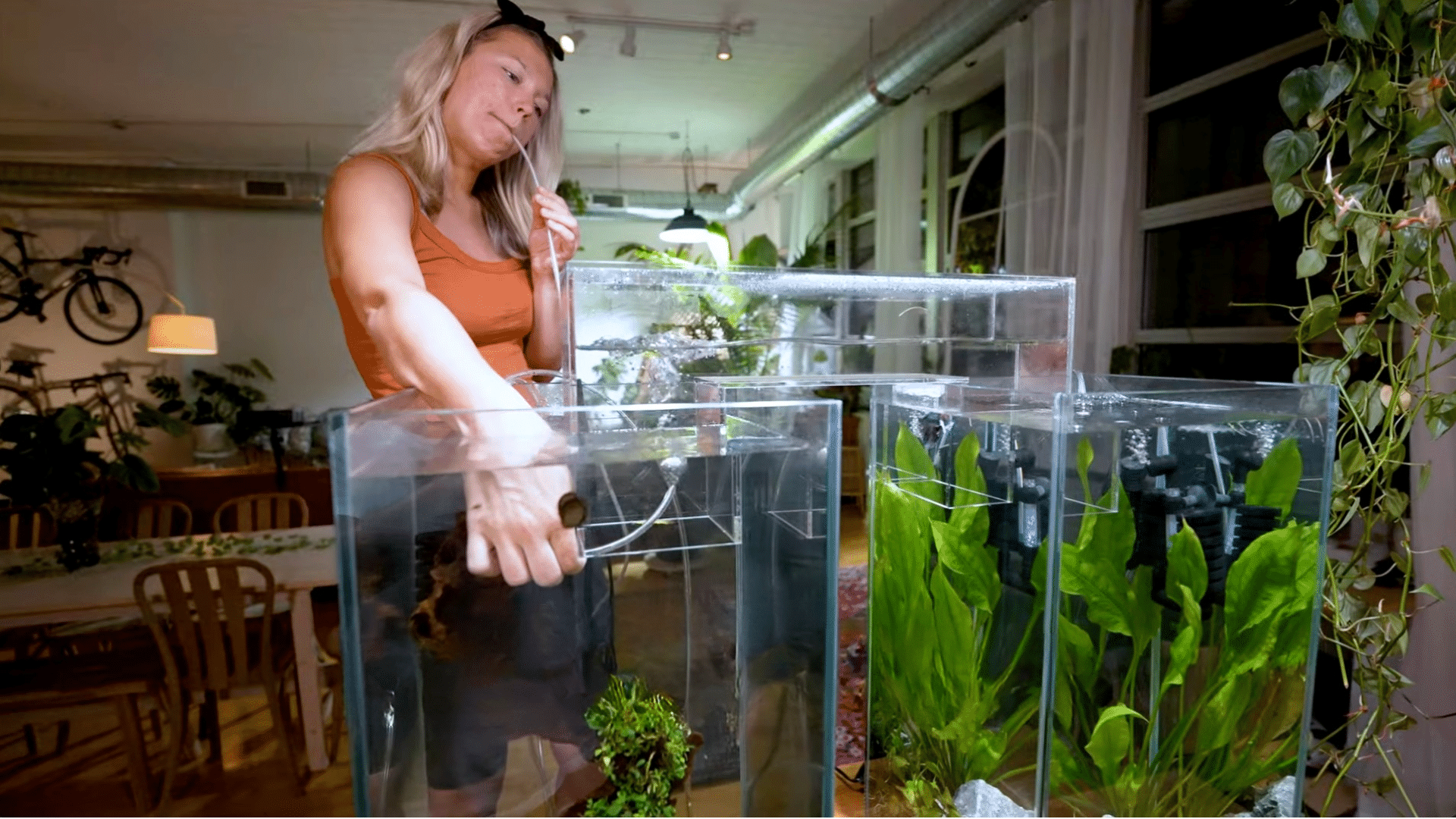
Before you start, unplug all electrical equipment like filters, heaters, and lights. Lay a towel under your tools to catch water drips.
Carefully remove decorations, stones, and any bridges or dividers.
If you use an acrylic bridge, gently blow air into it to release suction and balance pressure before lifting. This helps prevent stress on your fish and tank walls.
Place all removed items in a clean bucket with tank water to keep them moist and protect beneficial bacteria.
Step 2: Remove Visible Algae and Debris with Tweezers
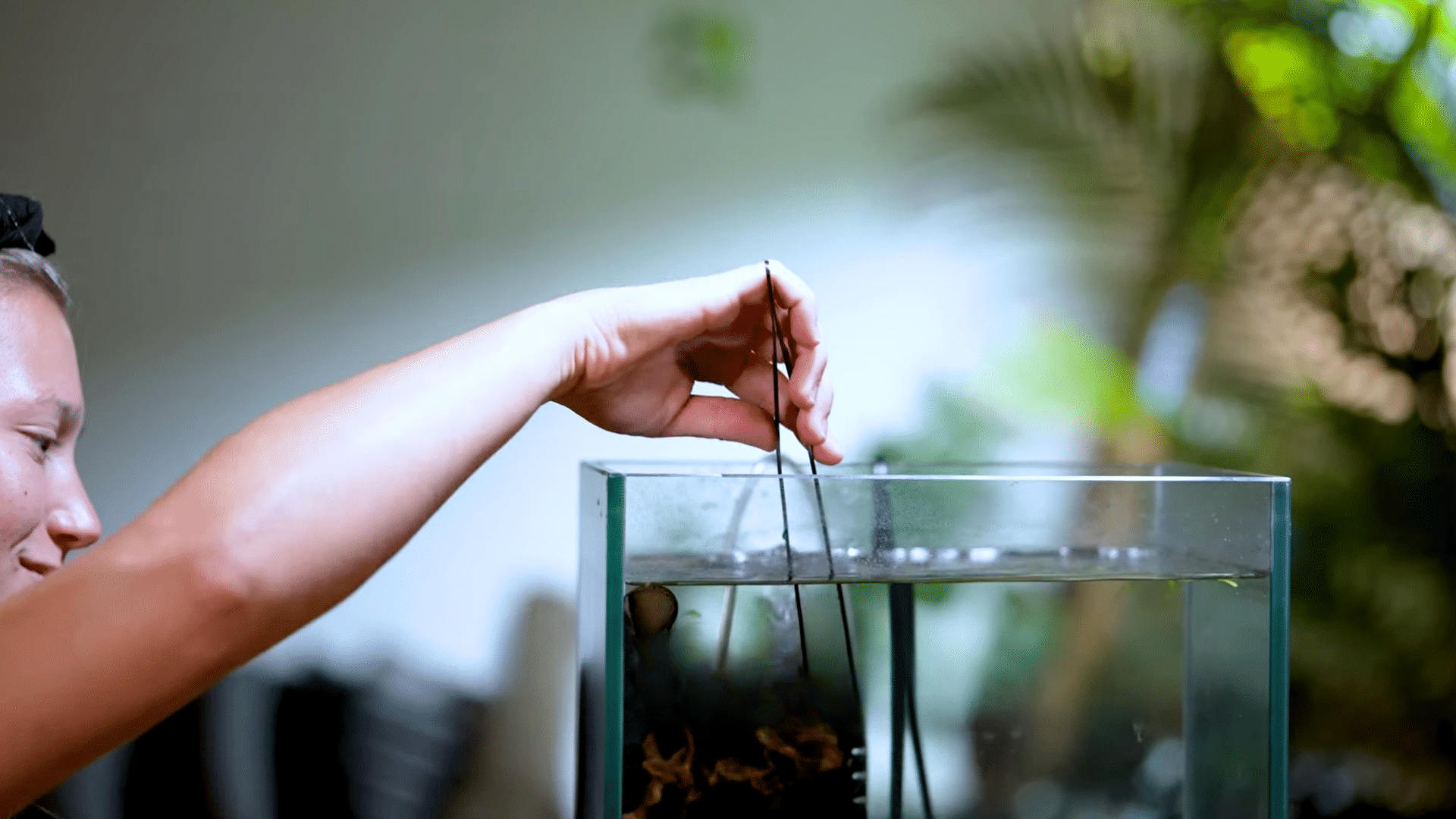
Use long tweezers to remove visible algae and debris from decorations, plants, and corners. Focus on stringy, green hair algae that tend to cling to leaves and ornaments.
The Amano shrimp help control algae, but heavy buildup often needs a manual touch.
Gently pluck large strands to prevent them from spreading and clouding the water. Be careful near delicate plants to avoid tearing leaves.
Removing this debris early keeps the tank cleaner and reduces how much waste your filter must handle later.
Step 3: Skim Floating Debris with a Net
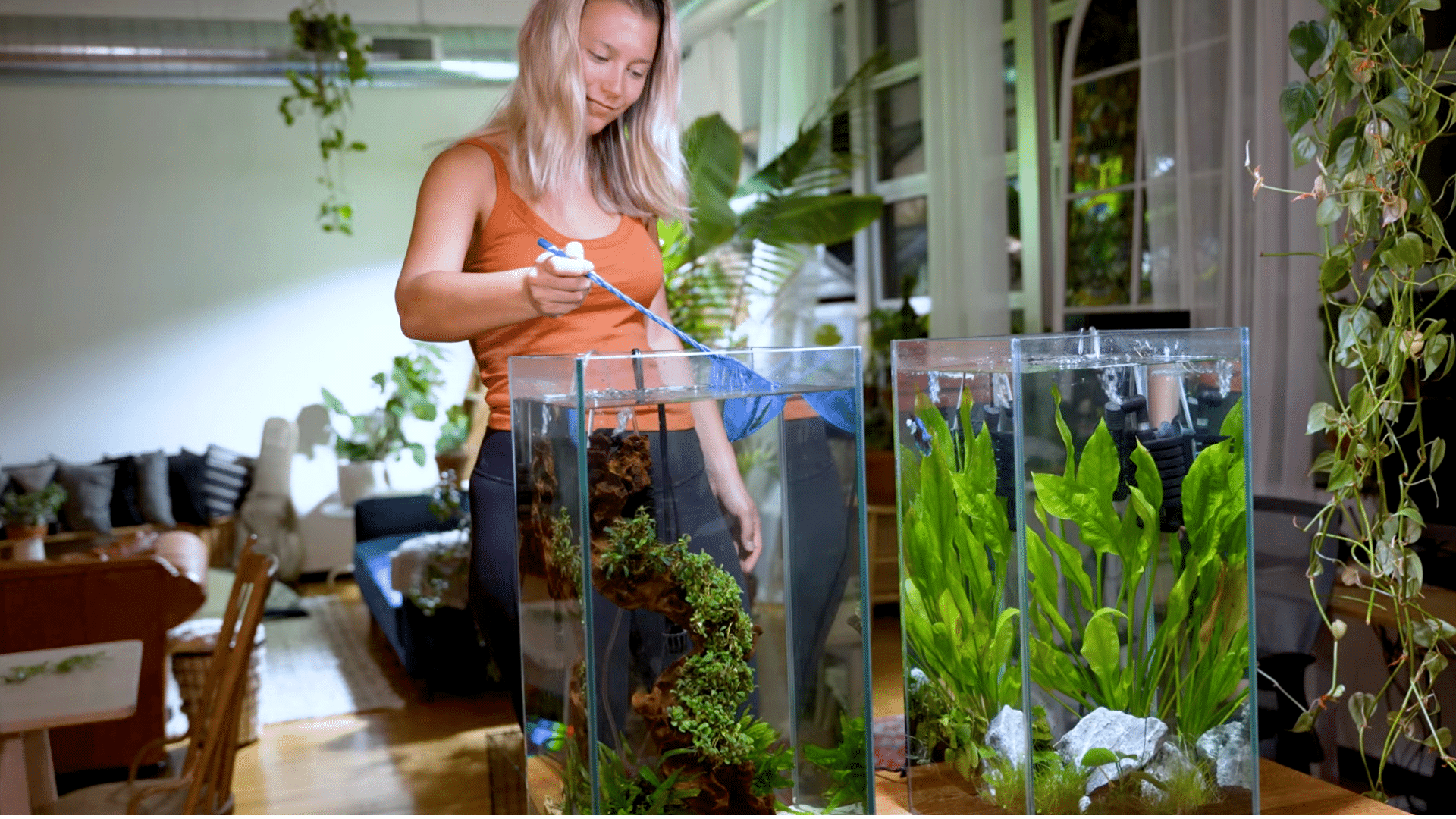
Take a fine-mesh net and move it gently across the tank’s surface in a slow figure-eight pattern.
This motion helps you catch floating debris like fish waste, leaves, and leftover food without stirring up more.
Skimming before a water change makes the next steps much easier since it prevents waste from settling on the bottom.
Rinse your net between sweeps to keep it effective. Regular skimming keeps the water looking clear and helps maintain a stable environment for your fish.
Step 4: Trim and Remove Soiled Plant Leaves
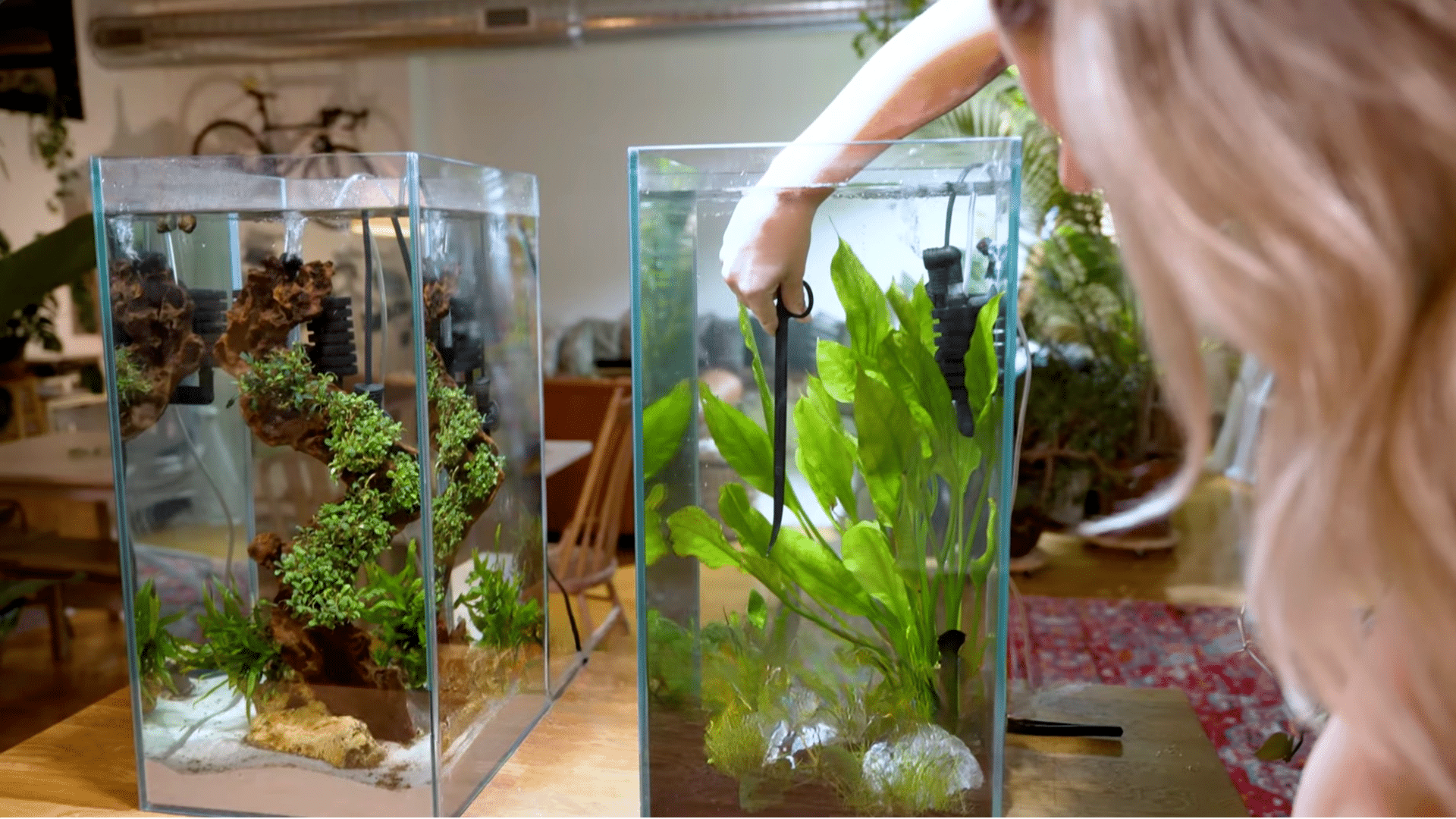
Healthy plants keep your aquarium balanced, so trimming them is essential. Use small scissors to cut away yellow, brown, or damaged leaves.
Decaying plant matter releases nitrates and feeds algae, so removing it helps keep the water cleaner.
As you trim, check for hidden algae growth on stems and leaves. Collect the clippings with your net to prevent them from floating around.
Regular trimming encourages new growth, improves oxygen levels, and gives your tank a neat, fresh look that benefits both plants and fish.
Step 5: Scrub Hard-to-Reach Areas with an Algae Pad
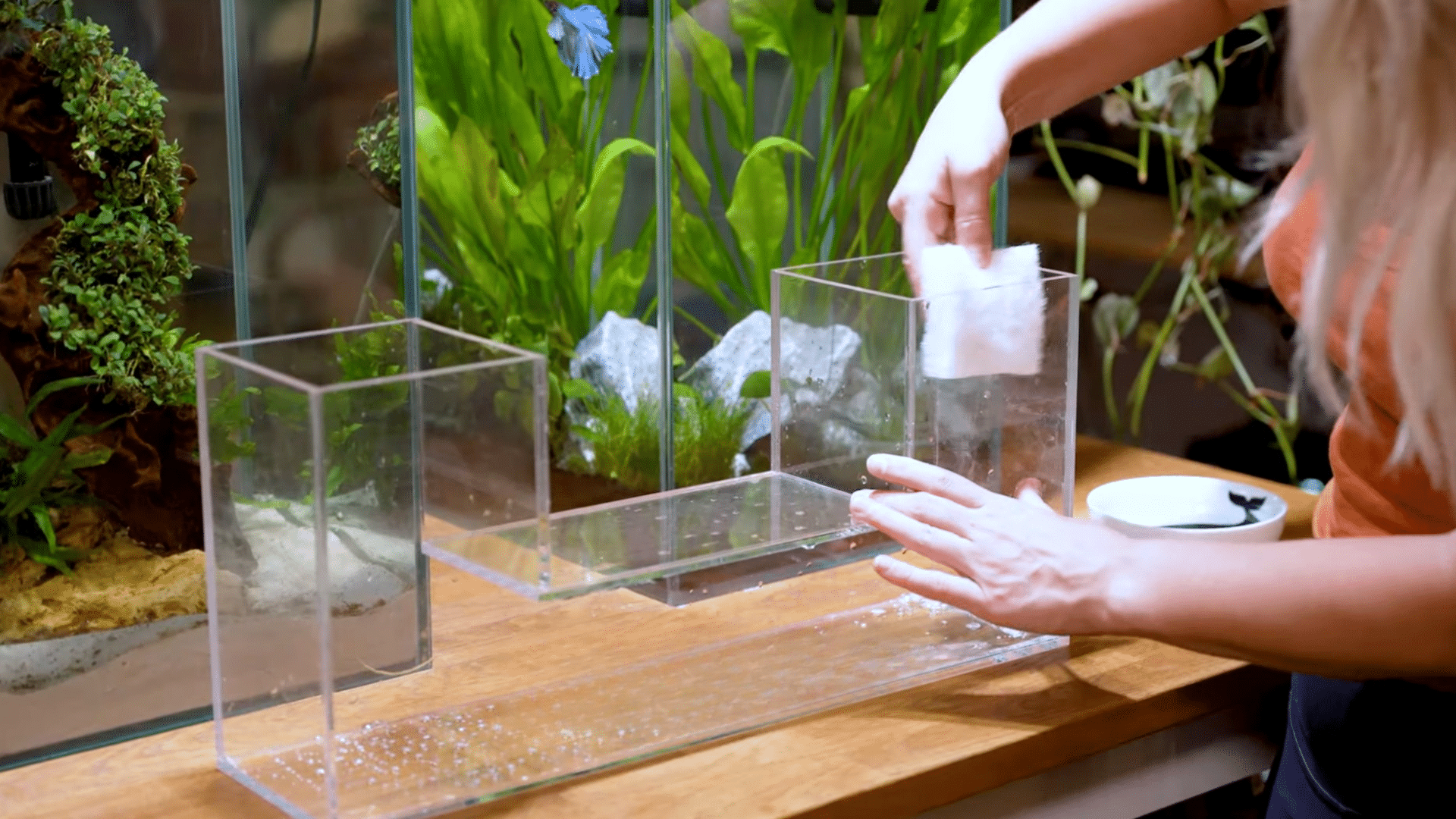
Use an algae pad designed for your tank type, soft pads for acrylic tanks, and standard ones for glass. Gently scrub algae from the glass, corners, and decorations.
Take time to clean under rocks or bridges where buildup often hides.
Avoid rough sponges or household cleaners, as they can scratch the surface or harm your fish. Rinse your pad regularly while cleaning to prevent spreading debris.
This simple scrubbing step makes your tank look brighter and keeps algae from taking over hard surfaces.
Step 6: Vacuum the Gravel and Siphon Water
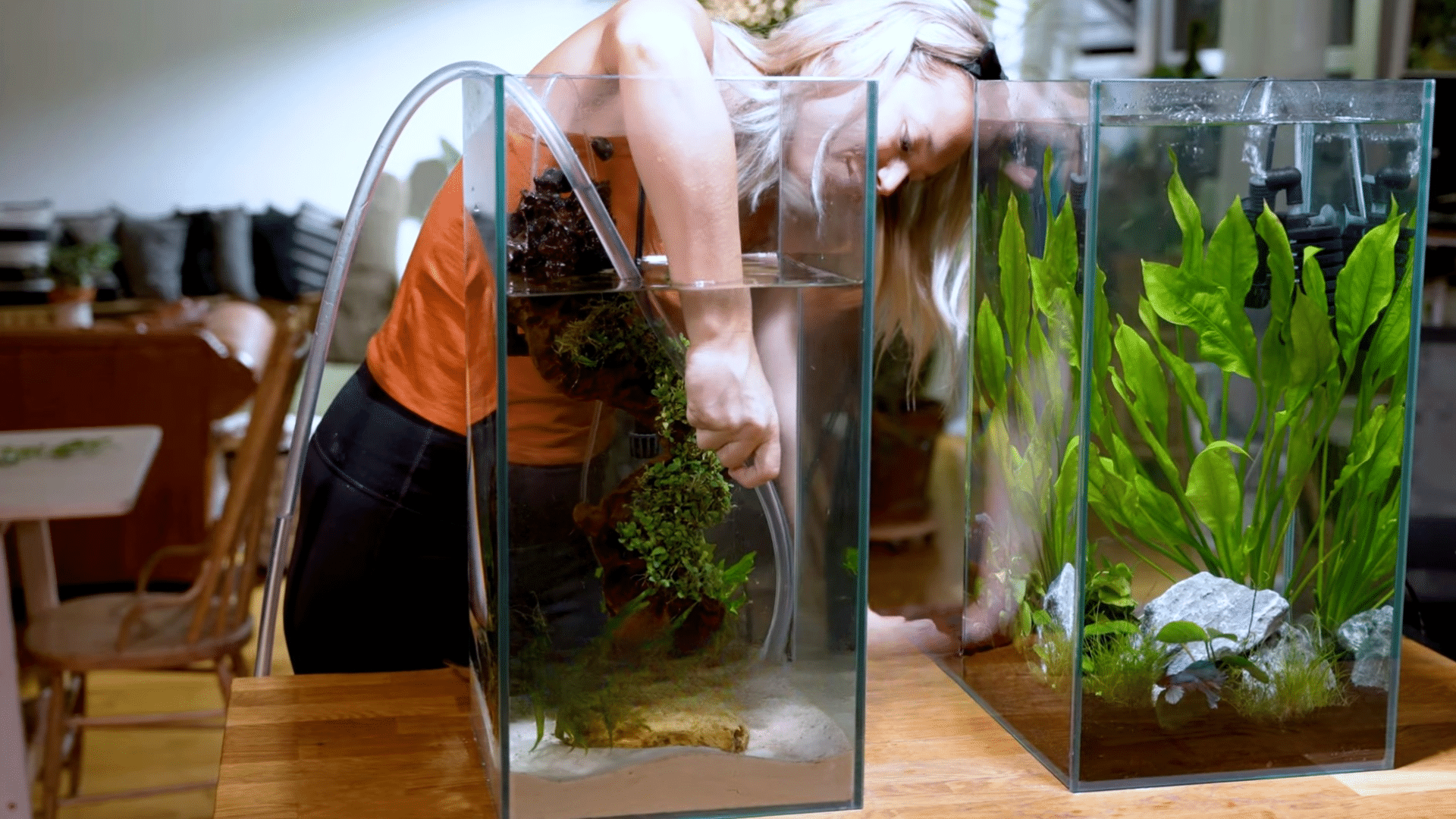
Use a siphon gravel vacuum to remove trapped waste and old food from the substrate. Move the siphon slowly through the gravel so debris is lifted without disturbing your fish.
During this process, remove about 25–30% of the tank water.
This small water change refreshes the environment without causing sudden changes in chemistry. Be sure to use a bucket dedicated to your tank only.
Gravel vacuuming not only improves water clarity but also prevents harmful gases and bacteria from building up over time.
Step 7: Gently Clean Sponge Filters
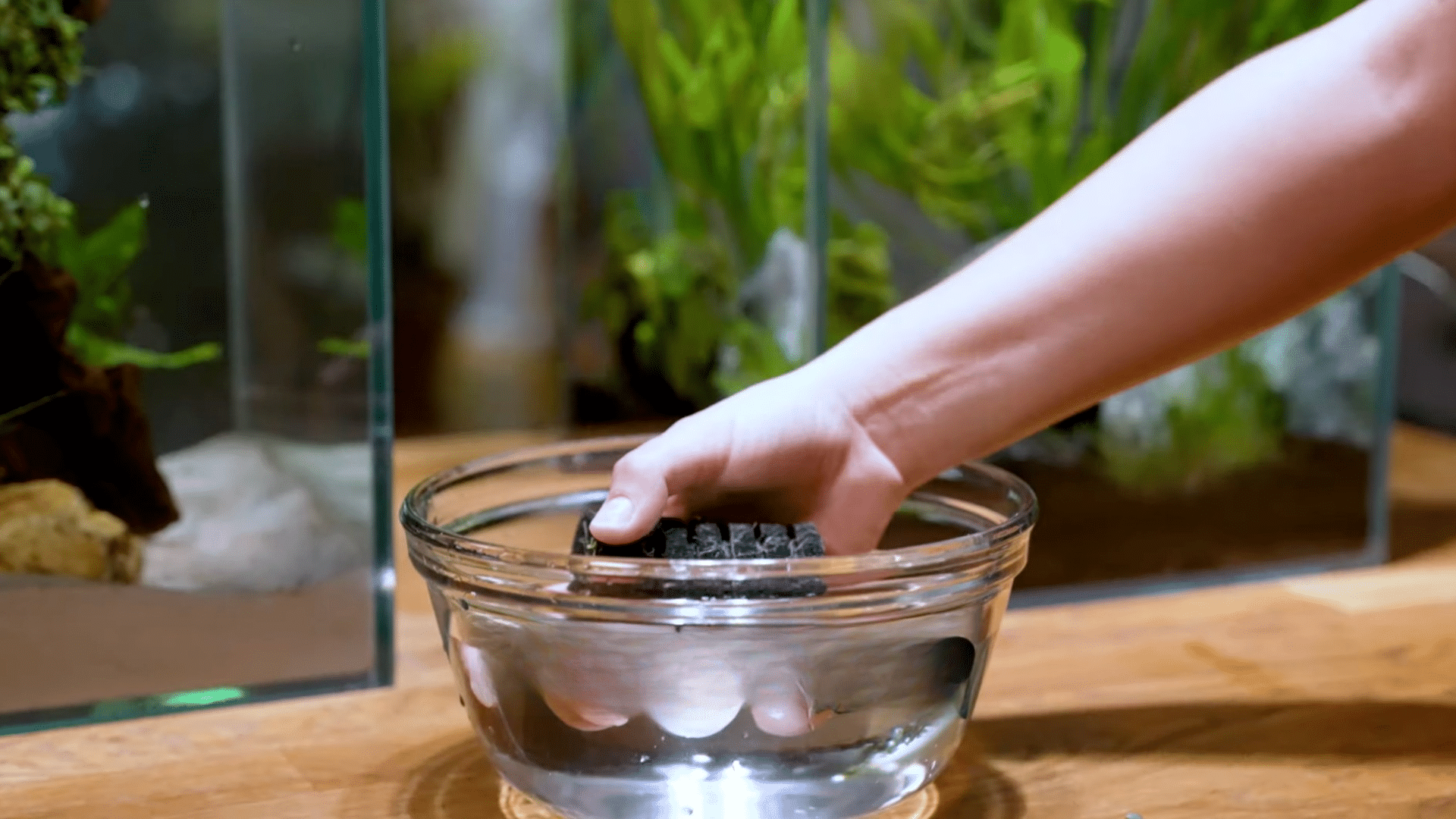
Sponge filters trap debris and hold beneficial bacteria essential for your tank’s balance. To clean them, remove the sponge and rinse it gently in a bowl of old tank water.
Avoid using tap water, as it contains chlorine that can kill good bacteria.
Gently squeeze the sponge to release dirt without crushing it. Once clean, place it back into the filter housing and restart the system.
This gentle cleaning keeps filtration strong while maintaining the biological balance that helps your fish stay healthy.
Step 8: Clean the Glass and Lower Surfaces
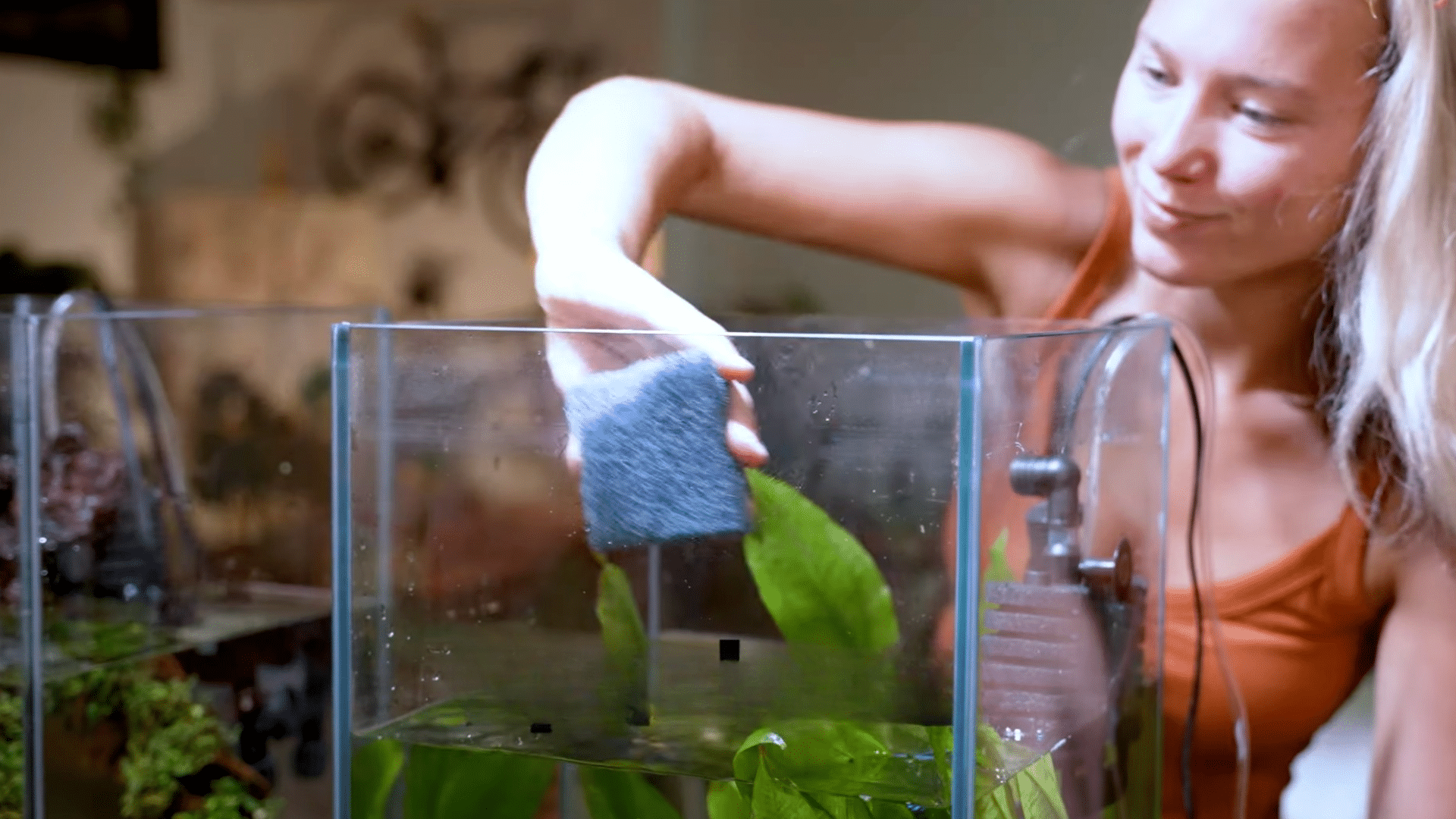
Wipe the inside glass with an algae pad or scraper, focusing on the bottom sections where buildup is most visible. Work slowly and evenly to avoid streaks or missed spots.
Then, use a damp cloth to clean the outside glass and tank rim, removing fingerprints, smudges, and water stains.
Regular glass cleaning not only keeps your aquarium looking clear but also lets more light through, which benefits plants and fish alike.
Doing this weekly helps you maintain that fresh, crystal-clear view.
Step 9: Replace Plants, Add Nutrients, and Top Off Water
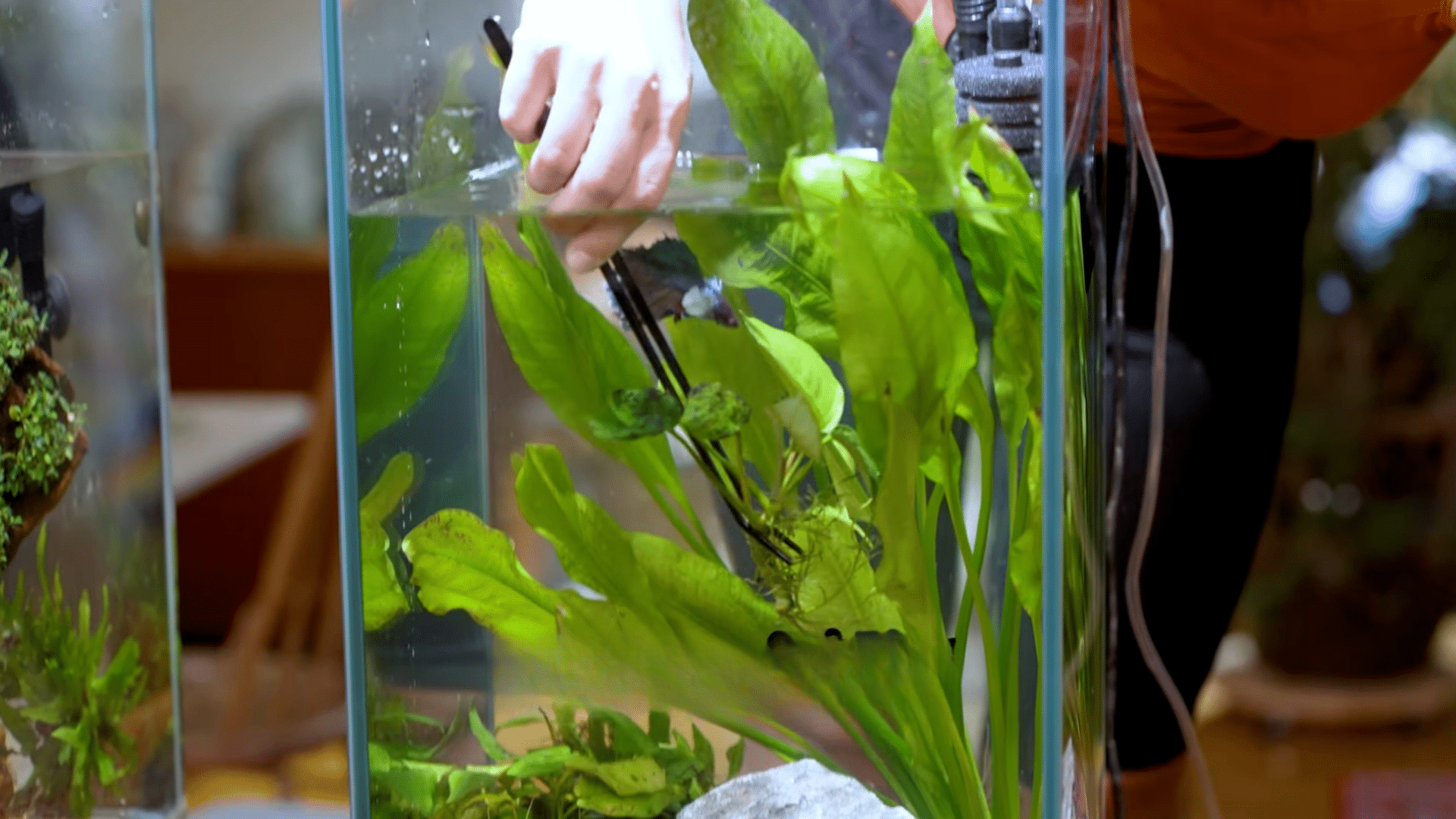
Once the cleaning is done, replant trimmed greenery and reposition decorations. Add root tabs near heavy root feeders to boost nutrients and support growth.
When refilling the tank, match the temperature of the new water to the existing tank water to avoid shocking your fish.
Always treat tap water with a dechlorinator or stress coat to remove harmful chemicals.
Refill the tank slowly to avoid disturbing the substrate, and check that your plants are secure once the water level is stable.
Step 10: Reinstall Decor and Restart Equipment
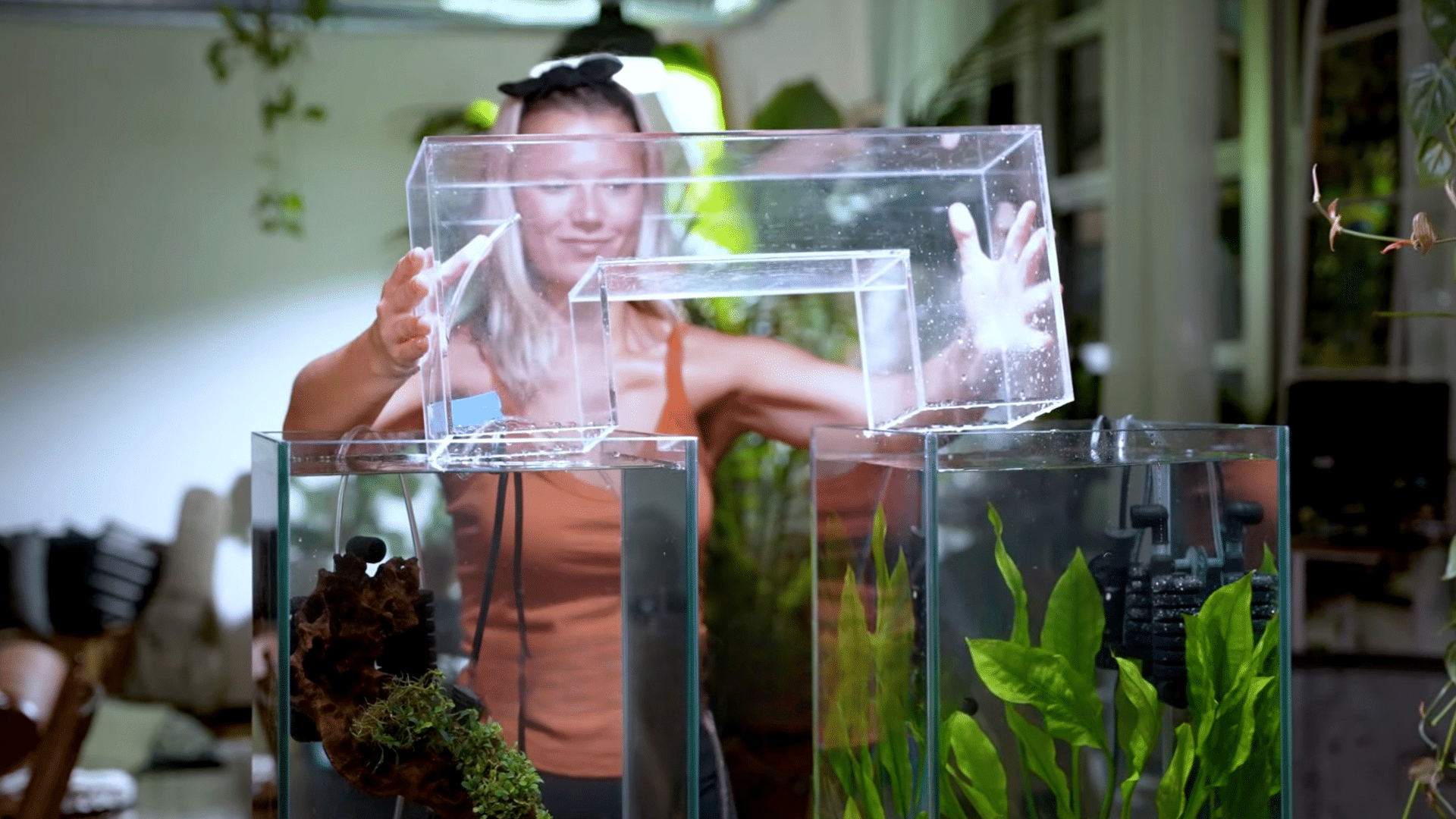
After refilling, carefully reinstall any bridges, dividers, or large ornaments. If you use a split-tank setup, use a small tube to remove trapped air from bridges so water levels balance naturally.
Once the bridge fills evenly, remove the tube and restart your filters, heaters, and circulation pumps.
Watch the tank for a few minutes to ensure everything runs smoothly.
Do one final net sweep for leftover debris. When finished, reward your fish with a small treat; they’ll appreciate their clean, refreshed home.
This tutorial is inspired by a great video from Aquarium Info. Huge thanks to the creator for sharing such a clear, detailed walkthrough. You can find the original video on their YouTube channel or watch it below.
How Often Do You Need to Clean Your Aquarium?
How often you need to clean your aquarium depends on its size, how many fish you have, and the type of filter you use. Small tanks usually need cleaning once a week since waste builds up faster in limited water.
Medium tanks can be cleaned every two weeks, while large tanks with good filters may only need a full cleaning once a month.
Still, partial water changes every week help maintain healthy water conditions.
If you notice cloudy water, debris, or algae on the glass, that’s a sign it’s time to clean. Staying on a regular cleaning schedule keeps your fish healthy, your tank water clear, and your equipment working longer.
Consistent care also helps you avoid sudden problems, like bad odors or sick fish, making aquarium upkeep simple and stress-free.
Tips for Keeping Your Aquarium Water Crystal Clear
Keeping your aquarium water crystal clear takes regular care, but it’s simple once you know what to do. Follow these easy tips to keep your tank fresh and your fish healthy.
- Avoid overfeeding: Extra food breaks down and clouds the water. Feed small amounts that your fish can finish in a few minutes.
- Do regular partial water changes: Replace 20–30% of the water weekly to remove waste and maintain balance.
- Add live plants: Plants absorb extra nutrients, helping control algae growth and keep the water clean.
- Use a good filter: Pick one that fits your tank size and clean it gently to protect helpful bacteria.
- Test your water often: Monitor ammonia, nitrite, and nitrate levels to spot issues early.
- Clean decorations regularly: Rinse or scrub algae off ornaments and rocks using old tank water.
- Maintain a stable temperature: Keep the water temperature steady to prevent stress and bacterial growth.
Common Mistakes to Avoid when Cleaning
Cleaning your fish tank seems simple, but a few small mistakes can harm your fish or upset the tank’s balance. These are some common errors to watch out for and how to avoid them.
- Replacing all the water at once: Changing all the water removes good bacteria that keep your tank healthy. Always replace only part of it.
- Using soap or harsh cleaners: These can leave toxic residues that harm fish. Use only aquarium-safe tools and water.
- Cleaning filters too thoroughly: Over-cleaning the filter removes helpful bacteria. Rinse it gently in old tank water instead.
- Forgetting to treat new water: Tap water often contains chlorine and other chemicals. Always use a water conditioner before adding it to your tank.
Conclusion
Keeping your aquarium clean isn’t just about looks; it’s about creating a safe, healthy home for your fish.
With a simple routine and the right tools, you can keep your tank clear, your fish stress-free, and your equipment working well.
Regular cleaning may seem small, but it makes a big difference over time.
Consistency keeps your aquarium healthy, and once it becomes part of your regular routine, you’ll see how simple it really is.
Take a little time each week to care for your tank, and you’ll see the rewards in clear water and happy fish.
Have your own tips or tricks for keeping an aquarium spotless? Share them in the comments. I’d love to hear how you make cleaning easier and more effective.


